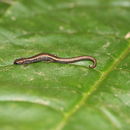Description
provided by AmphibiaWeb articles
Thorius boreas is a relatively large, more robust species of Thorius (Mexican minute salamanders), with a standard length range of 25.1 – 29.9 mm (average of 27.4 mm) in males and 24.7 – 34.9 mm (29.7 mm) in females. The head is narrow and female snouts are bluntly pointed, while males have a more sharply pointed snout. Males also have a protruding mental gland. The oval nostrils are large. From a dorsal view, their small eyes barely extend past jaw margins. A suborbital groove crosses the lip on each side. There are few premaxillary teeth, which range in number (average 2.2 premaxillary teeth in males and 4.3 in females). Vomerine teeth also range in number (9.9 average for males, 9.3 average in females). They lack maxillary teeth. The limbs are relatively long with moderately sized hands and feet. The two longest fingers and three longest toes are free and rounded while the other digits are pointed. Fingers, in order of decreasing length, are 3 > 2 > 5 > 1, and toes are 3 > 4 > 2 > 5 > 1. There are well-defined grooves and folds along body and tail. The postiliac gland is not obvious. The robust tail tapers at the tip only (Hanken and Wake 1994).Thorius boreas can be distinguished from other species of Thorius by it having dark dorsal and ventral coloration, a larger size, relatively large nostrils, and lack of maxillary teeth. Two other species of Thorius have sympatric ranges with T. boreas. Thorius boreas can be distinguished from T. aureus by darker coloration, larger nostrils, and lack of maxillary teeth. From T. macdougalli it can be distinguished by T. boreas's larger size, robust body, and relatively smaller nostrils (Hanken and Wake 1994). Thorius boreas can be further be distinguished from T. narisovalis by T. boreas being larger and having a more elongated nostril. Lastly, it can be distinguished from T. pulmonaris by elevation and by T. boreas being larger and having a smaller nostrils (Hanken and Wake 1994).In life, T. boreas is very dark, especially dorsally and laterally. The ventrum is slightly lighter in color. There is an inconspicuous broad dorsal stripe with wavy boarders on the dorsum. The stripe may have lighter colored chevrons or partial chevrons corresponding to the costal grooves. The venter has fine white speckling along the ventrolateral margins of the body, but is uniform on the gular area, main trunk, and tail. The mental gland is light colored and the iris is charcoal (Hanken and Wake 1994).In alcohol, the overall coloration of T. boreas is dark gray, particularly on the lateral sides, with a lighter, charcoal colored venter. An inconspicuous ebony dorsal stripe extends from eyes to base of tail and gradually disappears. The limbs are dark near the body but lighten in color toward the digits. Small gular guanophores are present. The mental gland appears white and the nasolabial protuberances are unpigmented (Hanken and Wake 1994).There is very little variation in coloration (Hanken and Wake 1994).The species authority is: Hanken J., D.B. Wake. 1994. Five New Species of Minute Salamanders, Genus Thorius (Caudata: Plethodontidae), from Northern Oaxaca, Mexico. Copeia 1994(3): 573-590.Thorius boreas belongs to the subfamily, Bolitoglossinae. Thorius species likely evolve via adaptive radiation. Based on analysis of mtDNA and RAG1 sequences data, T. boreas is sister to T. aureus (99% posterior probability) and together they are sister to the clade including T. narisovalis and T. minutissimus (Rovito et al. 2013). The species epithet, boreas, is Greek for “the north wind” and refers to the fact that the species’ elevation range is cool montane peaks above 2850 m (Hanken and Wake 1994).
- Parra-Olea, G., Wake, D.B., Hanken, J., García-París, M. (2008). Thorius boreas. The IUCN Red List of Threatened Species. Version 2014.3. www.iucnredlist.org. Downloaded in May 2015
- Rovito, S. M., Parra-Olea, G., Hanken, J., Bonett, R. M., Wake, D. B. (2013). ''Adaptive radiation in miniature: the minute salamanders of the Mexican highlands (Amphibia: Plethodontidae: Thorius).'' Biological Journal of the Linnean Society, 109, 622-643.
Distribution and Habitat
provided by AmphibiaWeb articles
This species is endemic to the Sierra de Juarez mountain range in Oaxaca, Mexico. It is only known from Cerro Pelon and Llano de las Flores, between elevations of 2850 m and 2950 m asl. It is limited to cool montane peaks in pine-oak and fir forest, generally at forest edges (Hanken and Wake 1994).
Life History, Abundance, Activity, and Special Behaviors
provided by AmphibiaWeb articles
Thorius boreas is a terrestrial salamander that reproduces via direct-development (Parra-Olea et al. 2008).
Life History, Abundance, Activity, and Special Behaviors
provided by AmphibiaWeb articles
Thorius boreas was once considered relatively common, but populations are currently in decline, especially in Cerro Pelon. Logging, habitat modifications and habitat quality decline cause population declines in other Thorius species, but it is not believed to be the main cause of T. boreas population declines. Declines in number of adult individuals in pristine habitat are not well understood and need further investigation (Parra-Olea et al. 2008).
Thorius boreas: Brief Summary
provided by wikipedia EN
Thorius boreas, commonly known as the boreal thorius, is a species of salamander in the family Plethodontidae. It is endemic to Oaxaca, Mexico, and only known from the Sierra Juárez. Its natural habitats are pine-oak and fir forests, often at forest edges. It is threatened by habitat loss (logging), although it does explain the dramatic decline that this species has seen.
- license
- cc-by-sa-3.0
- copyright
- Wikipedia authors and editors

